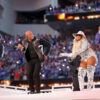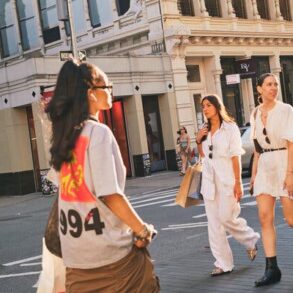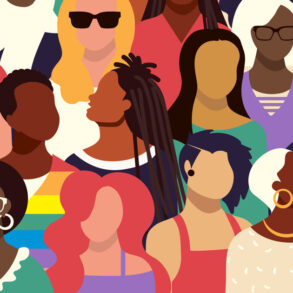People have birthdays and anniversaries. But how is it that hip-hop, an art form that has helped influence so much of pop culture in the United States and around the world, can trace its history down to a day?
Whether you’re a “hip-hop head” or someone still learning about the culture, here’s an explanation of how hip-hop got its 50th birthday, why people feel it’s important and some resources to help you celebrate or find out more about it.
How is hip-hop able to pinpoint a day to consider its 50th birthday?
On Aug. 11, 1973, a young woman from the Bronx threw a back-to-school party at her apartment complex’s recreation center. To keep costs manageable, she had her 18-year-old brother, known for his serious sound system, be the DJ.
That woman was Cindy Campbell, and her brother was Clive — better known to hip-hop aficionados as DJ Kool Herc.
Black American music — jazz, blues, rock n’ roll, rhythm & blues, funk — long preceded what would come to be known as hip-hop. Artists such as Kid Capri and Kurtis Blow list influences ranging from the Jubalaires, a gospel group first active in the 1930s, to comedian Pigmeat Markham to soul musician Jimmy Castor. Buckshot, from the group Black Moon, echoes the many who consider James Brown and George Clinton’s Parliament Funkadelic the foundation.
Yet it’s what Kool Herc did at that 1973 party that historians consider the invention of hip-hop. He played the break beats — the funkiest snippets of songs — in a continuous loop on two turntables, so the music, and therefore the dancing, never stopped.
From that point, the DJs became the stars of a party culture held mostly in New York City parks and nightclubs. It wasn’t until the early 1980s when the MCs on the microphone began to command most of the spotlight and the culture spread beyond New York. By the time Sugarhill Gang’s “Rapper’s Delight” hit the radio airwaves, hip-hop was on its way. (Scroll down for links to more hip-hop history.)
Why do artists feel the anniversary is important?
Before 2023, hip-hop often would only come together en masse when a revered artist, such as DMX or De La Soul’s Trugoy the Dove, died. This year has marked an occasion that a culture once described by Public Enemy (sampling Malcolm X) as “too Black, too strong” is able to celebrate what it has become.
“Hip-hop is a mosaic,” said Dante Ross, a longtime A & executive who influenced careers ranging from the Beastie Boys to Brand Nubian to MF Doom. “It’s made up of many pieces, colors, sizes, shapes. … it’s one of the greatest art forms ever.”
It’s become the epicenter of pop culture, Ross said. “Whether it’s streetwear or sneaker culture or street art or any of the tangents that revolve around it, they all trace back to hip-hop.”
Those who live and breathe the art form feel especially gratified by this moment because of how hip-hop was originally perceived. As former “Yo! MTV Raps” host Ed Lover recalled, hip-hop had been excluded from the Grammy Awards for years and was disregarded by so-called serious musicians as a novelty.
“I remember back in the ’80s when everybody thought that hip-hop was a fad and they thought it was going to die out,” Detroit producer Apollo Brown says. “It was like, ‘Oh, let our kids just have their fun for a little bit and then it will be all over with.’ Like, no. Hip-hop rules the world. Hip-hop is in every commercial you see. It’s in every movie … it’s on every billboard.”
He added, “It’s obviously not a fad anymore.”
Why do fans feel the anniversary is important?
For many people throughout the past 50 years, hip-hop has been the soundtrack to the highs and lows of life. The Post asked fans at the Rock The Bells Festival in Queens on Aug. 5 to articulate what it means to see a culture they love reach this milestone.
“To be out here for 50, it means taking a trip down memory lane,” said Ebony Green, whose late father, a DJ in Brooklyn’s Coney Island neighborhood, introduced her to hip-hop in 1986. “I’m thinking about being a little girl … just seeing all this stuff, thinking about the records I used to wipe down for him. … This is like a homecoming.”
Terrence John, whose father was also a DJ, was at the festival with Jennifer Morales, eager to see Ludacris, Run-DMC and others perform. At 22, John is younger than many of the artists they were there to see.
“I think a lot of the music I actually found on my own, and when I looked it up on the internet or there’d be one song I’d like and I’d have to hear more,” said John, who recalls always having headphones on as he was growing up. “And then maybe it would feature different artists, and now I’m going to [seek out] a different artist. And it just goes on from there.”
Makeda Armorer and Francoise Neptune are Alpha Kappa Alpha sorors who attended the festival to see Queen Latifah, Monie Love, MC Lyte, Salt-N-Pepa and others. Armorer recalled her formative years falling in love with hip-hop and her own desire to perform — under the name Divine Pee-Wee Tee.
Then, she said, hip-hop “was about what was going on in the street. And then it came out with the positive messages being in the community together … gangster rap, that’s not what it was all about. It’s uncommon today, but I think it was regular for a while. That’s what it was. It was consciousness. It was community. It was the village.”
Green, who was attending with a sister who’d surprised her with tickets that morning, and a cousin, has a family tied together through hip-hop. Her 18-year-old son, Ebon, is a fan, just as her DJ father was.
“I can’t think about hip-hop without thinking about my father,” she said. “Every lyric, every rhyme back and forth, singing with him, dancing with him, every time I went roller-skating with him.”
Hip-hop began as primarily an inner-city culture but grew to include everyone. As an art form, it’s dense and malleable enough to be whatever any creator wants it to be. It can be political, angry, fun-loving or poetic. Or, it can remind one of family.
“You get everything in 50 years of hip-hop,” Neptune said. “I mean, from the trap house to the White House, you will get everything. That’s why I love it. I mean, it’s great. You will find your lane.”
What are the four elements of hip-hop?
Though many people know hip-hop as the art of rhyming over a beat, purists consider hip-hop to be made up of four elements. They are:
Emceeing, or the art of rapping — talking, singing or delivering poetry over a beat. There are various acceptable styles and formats, and raps don’t necessarily have to rhyme, though they usually do. In more complicated forms, rappers might rhyme several times within the same couplet or musical bar.
Deejaying, or turntablism, is the art of manipulating the music by controlling two turntables or a DJ-friendly sound program to keep the music going or to create new sounds. (Learn more about turntablism at Brolic Army.) Similarly, hip-hop producers are responsible for laying the backdrop for many of its songs. Sampling is the art of taking recorded sounds and rearranging or manipulating them to create new soundscapes.
B-boying, or break dancing, is the art of expressing yourself through physical movement or dance. Here’s Red Bull’s All You Need to Know about break dancing, and a Post feature about its debut as an Olympic sport.
Graffiti, or graf, is an artistic expression through spraypainting, writing or other means. Britannica defines it as a form of urban communication. Masterworks cites its early history on New York subway trains. That allowed graf writers’ “tags” or “pieces” to move throughout the city and gain them recognition within the subculture.
How are The Washington Post and other outlets marking the 50th?
No organization or single project can cover every part of 50 years of such a significant part of American culture. But taken together — though you might need until the end of this 50th year to get through it all — you can get a pretty well-rounded picture.
The Post asked 50 hip-hop figures to share with us songs that made them feel the way they did when they first heard them, or those that inspired, impacted or influenced them. Instead of a definitive, ranked list, we intended for the artists’ picks to remind you of what you love too, or introduce you to songs you’d overlooked. You can listen with sound, or on Spotify, take our quiz on the non-hip-hop rappers enjoy, and read Chris Richards’ essay focused on the overlooked past 20 years of hip-hop.
Be on the lookout for a special episode of Post Reports on Aug. 11, hosted by Sean Carter (no, not that Shawn Carter) and telling hip-hop’s story through interviews with Rakim, Yo-Yo and Drumma Boy, among others.
We also took brief looks at moments in hip-hop history in our Retropolis section: At André 3000′s “The South Got Something To Say” moment and how “Rapper’s Delight” came to be.
Other legacy news organizations took creative looks at hip-hop culture as well. The Los Angeles Times took a one-standout-moment-per-year approach, while the New York Times had 50 rappers tell 50 stories, published an ode to 63 rappers who died too young and another to bling. An Associated Press project broke hip-hop up into Rhythm, Rhyme, Reinvention and Respect, examining politics, women’s influence, and hip-hop’s relationship with sports.
The Atlanta Journal-Constitution releases its Southern hip-hop documentary on Nov. 2. Netflix, meantime, premiered “Ladies First: A Story of Women in Hip-Hop” on Aug. 9.
Good Morning America is running a series of “Hip-Hop Turns 50” interviews this week, beginning with Offset, Jeezy and GloRilla. It also produced Angie Martinez’s Hip-Hop @ 50: Rhythms, Rhymes & Reflections in June, which is available on Hulu.
Audacy’s Hip-Hop Made series features a greatest 50 songs countdown, and interviews with artists such as Busta Rhymes, Flo-Rida and Fatman Scoop.
Audible’s Hip-Hop Forever features hip-hop memoirs, podcasts and performances from Black Thought, Snoop Dogg, Yasiin Bey and DJ Drama.
What are some resources where I can learn more about hip-hop history?
Whether you’re an old head or new to the game, if you love the music, there are plenty of ways to satisfy the fascination. Here’s a sampling (no pun intended):
Documentaries such as Ice-T’s “Something From Nothing: The Art of Rap,” Netflix’s Hip-Hop Evolution, Showtime’s Wu-Tang Clan: Of Mics and Men, and the hip-hop fashion exploration Fresh Dressed.
Classic hip-hop movies such as Wild Style, Beat Street, Krush Groove, Breakin’ and 8 Mile. Complex ranked 36 of its favorites, and Okayplayer ranked 20 hip-hop B-list movies.
Books such as “Ego Trip’s Book of Rap Lists,” Brian Coleman’s “Check The Technique” (and its predecessor, “Rakim Told Me”), Oliver Wang’s “Classic Material: The Hip-Hop Album Guide,” Jeff Chang’s “Can’t Stop, Won’t Stop,” Dan Charnas’s “The Big Payback: The History of the Business of Hip-Hop,” and our own Geoff Edgers’s “Walk This Way.”
Cultural resources such as the National Hip-Hop Museum in Washington and the Universal Hip-Hop Museum in the Bronx; NYC Tourism’s guide to visiting hip-hop sites in New York; KRS-One’s Temple of Hip-Hop; a visual exhibit at Seattle’s Museum of Pop Culture and another that recently wrapped at the Baltimore Museum of Art; the Book of Hov Jay-Z exhibit at Brooklyn Public Library; and KQED’s year-long Bay Area hip-hop exploration.
Events such as these hip-hop festivals and tours we wrote about earlier this summer (although the dates for The F.O.R.C.E Live tour, which begins Aug. 11 in Baltimore, have since changed); other locally focused events, such as RVA Rapper’s Delight in Richmond or a block party in St. Louis; take a look around for events near you on or near Fri. Aug. 11. There are also events scheduled for the Sedgwick Ave. rec room where hip-hop began; KRS-One and Kid Capri are expecting thousands to attend events there on Aug. 11 and 12. Check out birthplaceofhiphop.nyc for more information.
Podcasts such as Philaflava’s Take It Personal, N.O.R.E. and DJ EFN’s Drink Champs, Talib Kweli’s The People’s Party, Peter Rosenberg and Cipha Sounds’s Juan Ep is Life and Math Hoffa’s My Expert Opinion. If you really want to dig in the crates, seek out episodes of the Combat Jack Show. Reggie Ossé did some of the culture’s most in-depth interviews before he died in 2017.
And of course, there are always the radio stations and streaming services, such as SiriusXM, Apple Music and Spotify, where you can get your fix, if you don’t have crates of records or shoe boxes filled with tapes. After all, as Dante Ross reminded us, hip-hop is “the centerpiece of pop culture … it’s changed the world in ways that are immeasurable.”
Ben Brasch contributed to this report.







